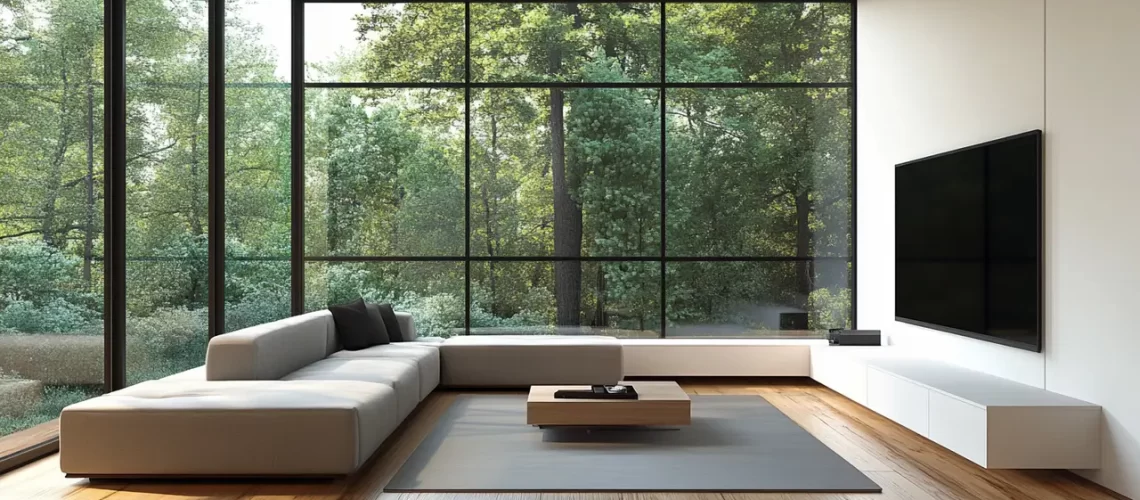Dive into the elegance of minimalism—a design philosophy where less is more, and simplicity reigns supreme.
Understanding Minimalist Interior Design
Minimalist interior design is based on the idea of stripping down decor to its essential quality, fostering a sense of clarity and freedom. By focusing on a handful of key components rather than overloading a room with decor, minimalist design promotes tranquility and functionality.
The philosophy of ‘less is more’ guides minimalist interior design, emphasizing clean lines, a monochromatic color palette, and the thoughtful use of space. Each element within the room has a place and purpose, reducing clutter and enhancing the room’s overall aesthetic.
The Importance of Decluttering
Starting with a decluttering process is foundational in achieving a minimalist living room. This involves removing unnecessary items and keeping only what is necessary, favoring quality over quantity. It’s an initial step that helps in creating a serene and spacious environment.
The act of decluttering goes beyond just physical space—it impacts mental well-being, reducing stress and fostering a sense of calm. Emphasizing space over things, decluttering is not about creating an empty space, but rather about making room for meaningful engagement and interaction.
Choosing a Neutral Color Palette
A neutral color palette is a hallmark of minimalist interior design, creating a soothing and cohesive look. Shades of white, beige, gray, and earth tones work harmoniously to establish a serene ambiance that amplifies natural light and enhances spatial perceptions.
Implementing a neutral color palette allows for flexibility in design and the ability to easily incorporate changes or accents without disrupting the minimalist ethos. It serves as a blank canvas, inviting creativity within the framework of simplicity.
Selecting the Right Furniture
When selecting furniture for a minimalist living room, prioritize items that combine functionality with aesthetic appeal. Opt for pieces with clean lines and simple shapes that contribute to a sense of spaciousness and order.
Furniture in a minimalist setting should offer versatility and be chosen with intention, avoiding overcrowding. Each piece should serve a practical purpose or bring joy, aligning with the minimalist principle of intentionality in design.
Investing in high-quality furniture that withstands the test of time is key in minimalist design, reflecting the ethos of valuing substance over quantity. This approach ensures that the living room remains both functional and stylish, adapting to life’s changing needs.
Accentuating with Minimalist Decor
In minimalist interior design, decor is used sparingly, with each item selected to complement the space without overwhelming it. Think subtle art pieces, textured fabrics, and natural elements that add depth and warmth.
Accent pieces should speak to the homeowner’s personal style while maintaining the minimalist’s clean aesthetic. This can include strategically placed plants, a singular piece of artwork, or a statement furniture piece that serves as a focal point.
Incorporating Natural Light
Maximizing natural light is essential in minimalist design, helping to create an open, airy feeling that enhances the sense of space. Large windows, sheer window treatments, and strategically placed mirrors can amplify light, contributing to the room’s ambiance.
The use of natural light not only contributes aesthetically but also promotes well-being, connecting the indoor environment to the natural world outside. It’s a simple yet profound way to add a sense of spaciousness and calm to the living room.
Maintaining a Minimalist Space
Maintaining a minimalist interior design requires regular reevaluation of what items are necessary and meaningful. It’s an ongoing process of decluttering and refining, ensuring the living room remains a place of relaxation and clarity.
Embracing minimalism is about adopting a mindful approach towards possessions and space, recognizing that less can indeed be more. It’s a lifestyle choice that values simplicity, order, and an uncluttered aesthetic, fostering a sense of peace and contentment.
The Essence of Minimalism
Embracing minimalist interior design in your living room not only declutters the space but also declutters the mind. It’s a journey towards creating a tranquil haven that reflects a sense of peace and serenity, where every piece holds purpose and beauty.


